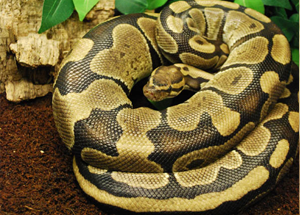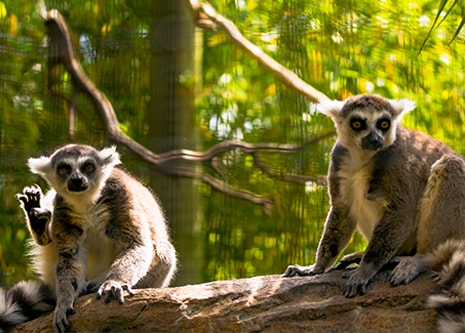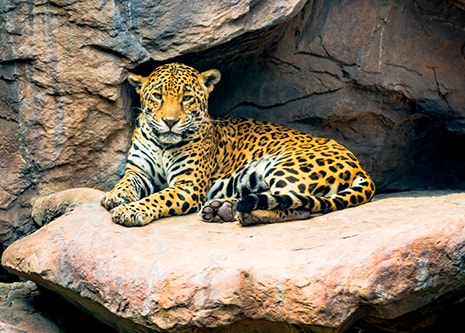
- VisitSupport Happy HollowDONATE TODAYExploreSupport Happy HollowDONATE TODAYLearnSupport Happy HollowDONATE TODAYSupport
-
Today's Hours: 10:00 am to 4:00 pm
Education AmbassadorsBall Python

Scientific name: Python regius
Family: Pythonidae
Order: Squamata
Class: Reptilia
Range: Central and Western Africa
Habitat: Forest, Grassland
Lifespan: 20 to 30 years in captivity; less in the wildWhat do they look like?
Ball pythons average three and a half to five feet long at adulthood. They are relatively heavy-bodied snakes. Thin necks support noticeably wider, flattened, pear-shaped heads. Ball pythons have pits along the top jaw that perceive heat, forming thermal images of their surroundings. Ball pythons are generally chocolate brown to black with medium to light brown spots and splotches lining their sides. They also have a broken dorsal stripe along their back. Ball pythons have lighter underbellies, typically white, cream or grey in color. Their spotted coloration allows them to camouflage well in grass and scrub environments, keeping them safe from predators while allowing them to hunt their prey under cover.How do they behave?
Ball pythons are typically nocturnal (active at night) or crepuscular (most active during dawn and dusk). They spend most of their time on or under the ground in burrows. When resting, startled or defensive, these pythons curl tightly into a ball, concealing their vulnerable head amongst the coils. This behavior gives them their name. Ball pythons are not venomous; instead they suffocate their prey through constriction.What do they eat?
In the wild ball pythons feed mainly on small mammals and the occasional small bird. At Happy Hollow, they eat mice. Like most constrictors, ball pythons have backwards pointing teeth, which aid in holding on to their prey. Ball pythons do not chew their food, instead they swallow it whole. In times when food is scarce, ball pythons can slow down their metabolism, to burn less energy, until food becomes readily available.How are they born?
Ball pythons are oviparous (egg-laying) reptiles. Clutches consist of four to 10 leathery eggs which hatch approximately 55 to 60 days after being laid. Females are very attentive of their clutches and will guard the eggs throughout incubation. The female ball python will stay with the clutch, using her body to maintain consistent temperature and humidity for her eggs. During this time, she will not leave her eggs, not even for a meal.Conservation
Ball pythons are common throughout their range in Africa and their conservation status is listed by the International Union for Conservation of Nature as Least Concern. Wild ball python populations are currently stable, however excessively catching wild ball pythons for the pet trade could lead to a threatened status. Wild-caught animals will often refuse to eat in captivity and can carry parasites. Poor conditions of importation often lead to stressed and aggressive animals. If you would like to help ball pythons, do not support the illegal pet trade by purchasing wild-caught ball pythons. Make sure potential pets are captive-bred in the United States rather than being imported from Africa. If you are considering a ball python as a pet, make sure to do your research and consider adopting from your local animal shelter or reptile rescue group. For more information on reptile rescue in the bay area check out the Bay Area Amphibian and Reptile Society at www.baars.org
Zoo on the Hill
Located across from the Keep-Around Carousel is the Zoo on the Hill. Learn about wildlife up close during daily meet-and-greets, leap like a lemur on the playground, brush and feed the goats,, or take a peek inside Doc’s Critter Care building and the Ranch House. Double-H Ranch features a combination of animal exhibits, including giant anteaters and red ruffed lemurs, as well chickens and domesticated animals that are docile enough to touch.
See Animals
Zoo in the Hollow
Follow the crooked bamboo pathway down into the hollow and visit with some of the most amazing animals in the world. Where else in San José can you get up close to a stunning jaguar, lemur, meerkat or American alligator? Happy Hollow is dedicated to helping save species and preserve wildlife for future generations by participating in Species Survival Plan programs through the Association of Zoos and Aquariums.
See AnimalsVisit Us Today
Plan an unforgettable experience at San Jose’s family-friendly park and zoo.
more info